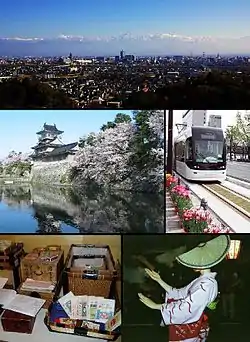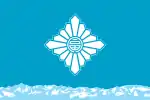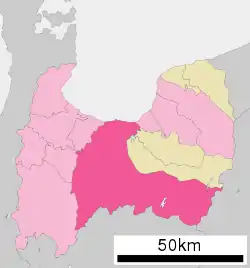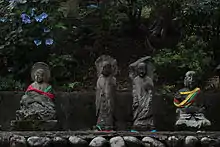Toyama (city)
Toyama (富山市, Toyama-shi, Japanese: [toꜜjama]) is the capital city of Toyama Prefecture, Japan, located on the coast of the Sea of Japan in the Chūbu region on central Honshū, about 200 km (120 mi) north of the city of Nagoya and 300 km (190 mi) northwest of Tokyo. As of 1 June 2019, the city had an estimated population of 415,844 in 176,643 households,[2] and a population density of 335 persons per km². Its total area was 1,241.77 square kilometres (479.45 sq mi).
Toyama
富山市 | |
|---|---|
 | |
 Flag  Seal | |
 Location of Toyama in Toyama Prefecture | |
 Toyama | |
| Coordinates: 36°41′45.3″N 137°12′49.3″E | |
| Country | |
| Region | Chūbu |
| Prefecture | |
| First official recorded | 6th century AD |
| City settled | April 1, 1889 |
| Government | |
| • Mayor | Masashi Mori |
| Area | |
| • Core city | 1,241.77 km2 (479.45 sq mi) |
| Population (June 1, 2019) | |
| • Core city | 415,844 |
| • Density | 330/km2 (870/sq mi) |
| • Metro [1] (2015) | 1,066,328 (16th) |
| Time zone | UTC+9 (JST) |
| Postal code | 930-8510 |
| Symbols | |
| • Tree | Zelkova serrata |
| • Flower | Helianthus annuus |
| • Flowering tree | Camellia japonica |
| Phone number | 076-431-6111 |
| Address | 7-38 Shinsakuramachi, Toyama-shi, Toyama-ken |
| Website | Official website |

The city has been designated an environmental model city by the national government for its efforts to reduce the emission of greenhouse gases.
Geography
Located in the middle of its prefecture, Toyama is a seaside city by the coast of the Sea of Japan. Its municipal territory borders with the Gifu Prefecture and with the municipalities of Imizu, Namerikawa, Tonami, Nanto, Hida and Takayama.[3]
The nearest towns are Imizu (west), and Namerikawa (east), both by the sea and part of the Toyama urban area. The nearest city is Kanazawa, the capital of Ishikawa Prefecture, which is 65 km (40 miles) away.
Surrounding municipalities
- Toyama Prefecture
- Nagano Prefecture
- Gifu Prefecture
Demographics
Per Japanese census data,[4] the population of Toyama has grown over the past 40 years.
| Census Year | Population |
|---|---|
| 1970 | 350,085 |
| 1980 | 391,554 |
| 1990 | 408,942 |
| 2000 | 420,804 |
| 2010 | 421,953 |
Foreign populations in Toyama:
| Ethnicity | Population |
|---|---|
| Chinese | 3,918 |
| Filipino | 1,452 |
| Brazilian | 1,423 |
| Korean | 871 |
| Vietnamese | 837 |
| Pakistani | 465 |
| Indonesian | 152 |
| American | 145 |
| Others | 1,505 |
Climate
Toyama has a humid subtropical climate (Köppen climate classification Cfa) with hot, humid summers and cool winters. Precipitation is abundant throughout the year, particularly in July, September and from November through January. Despite winter in Toyama being relatively mild, its position near the Sea of Japan places it within the heavy snow belt of Japan and on average 3.8 m (12 ft) of snow falls each season, almost all of it from December through March, as well as occasionally experiencing some tremendous amounts of snowfall.
| Climate data for Toyama, Toyama (1981–2010) | |||||||||||||
|---|---|---|---|---|---|---|---|---|---|---|---|---|---|
| Month | Jan | Feb | Mar | Apr | May | Jun | Jul | Aug | Sep | Oct | Nov | Dec | Year |
| Record high °C (°F) | 20.9 (69.6) |
22.5 (72.5) |
25.7 (78.3) |
32.4 (90.3) |
32.6 (90.7) |
36.4 (97.5) |
38.8 (101.8) |
39.5 (103.1) |
38.3 (100.9) |
33.3 (91.9) |
29.2 (84.6) |
21.6 (70.9) |
39.5 (103.1) |
| Average high °C (°F) | 6.0 (42.8) |
6.8 (44.2) |
10.9 (51.6) |
17.3 (63.1) |
21.9 (71.4) |
25.1 (77.2) |
29.0 (84.2) |
30.9 (87.6) |
26.5 (79.7) |
21.1 (70.0) |
15.3 (59.5) |
9.6 (49.3) |
18.4 (65.1) |
| Daily mean °C (°F) | 2.7 (36.9) |
3.0 (37.4) |
6.3 (43.3) |
12.1 (53.8) |
17.0 (62.6) |
20.9 (69.6) |
24.9 (76.8) |
26.6 (79.9) |
22.3 (72.1) |
16.4 (61.5) |
10.8 (51.4) |
5.7 (42.3) |
14.1 (57.4) |
| Average low °C (°F) | −0.1 (31.8) |
−0.3 (31.5) |
2.2 (36.0) |
7.2 (45.0) |
12.6 (54.7) |
17.4 (63.3) |
21.5 (70.7) |
22.9 (73.2) |
18.8 (65.8) |
12.4 (54.3) |
6.8 (44.2) |
2.4 (36.3) |
10.3 (50.5) |
| Record low °C (°F) | −11.9 (10.6) |
−11.1 (12.0) |
−7 (19) |
−2.2 (28.0) |
2.3 (36.1) |
7.7 (45.9) |
13.0 (55.4) |
14.1 (57.4) |
8.9 (48.0) |
1.9 (35.4) |
−2 (28) |
−8.5 (16.7) |
−11.9 (10.6) |
| Average precipitation mm (inches) | 259.5 (10.22) |
172.1 (6.78) |
158.5 (6.24) |
122.2 (4.81) |
134.2 (5.28) |
182.6 (7.19) |
240.4 (9.46) |
168.3 (6.63) |
220.2 (8.67) |
160.7 (6.33) |
234.4 (9.23) |
247.0 (9.72) |
2,300.1 (90.56) |
| Average snowfall cm (inches) | 159 (63) |
125 (49) |
36 (14) |
1 (0.4) |
0 (0) |
0 (0) |
0 (0) |
0 (0) |
0 (0) |
0 (0) |
2 (0.8) |
57 (22) |
380 (149.2) |
| Average precipitation days (≥ 0.5 mm) | 23.7 | 19.9 | 18.7 | 13.1 | 11.8 | 12.3 | 14.7 | 11.0 | 13.9 | 14.4 | 17.7 | 22.0 | 193.2 |
| Average snowy days | 19.1 | 16.1 | 9.1 | 0.8 | 0 | 0 | 0 | 0 | 0 | 0 | 1.0 | 9.7 | 55.8 |
| Average relative humidity (%) | 82 | 79 | 73 | 69 | 72 | 79 | 81 | 77 | 79 | 77 | 77 | 80 | 77 |
| Mean monthly sunshine hours | 68.1 | 86.3 | 131.3 | 174.9 | 191.1 | 150.2 | 147.1 | 201.3 | 133.1 | 142.7 | 102.8 | 75.8 | 1,604.7 |
| Source 1: Japan Meteorological Agency[5] | |||||||||||||
| Source 2: Japan Meteorological Agency (records)[6] | |||||||||||||
History
Early history
The area of present-day Toyama city was part of ancient Etchū Province. The Toyama Plain is good farmland and historically it was a point of strategic and traffic importance since prehistoric times. During the Sengoku period, it was frequently a battlefield, coming under the control of warlord Sassa Narimasa, who built a castle town around Toyama Castle and channeled rivers to bringing about a flourishing agricultural industry. The area subsequently became part of Kaga Domain under the Maeda clan during the Edo period, during which time a positive industrial promotion policy was implemented on the production of Chinese medicine and washi (Japanese paper). Also, thanks to the improvement of kitamaebune sea transportation routes, these industries thrived and Toyama became known nationwide as the province of medicine.
Recent history
After the Meiji Restoration, with the creation of the municipalities system, the city of Toyama was established on April 1, 1889, as one of the first 30 cities in Japan. Economically, the area developed heavy and chemical industries based on abundant hydroelectric electricity. Toyama has become one of the most influential cities on the Sea of Japan with its good water supply, drainage system and thriving agricultural, forestry, fishery, commercial and manufacturing industries.
During World War II, Allied Prisoners of War (POWs) were sent to Toyama as forced labor.[7] The city was almost completely destroyed on the night of August 1–2, 1945. At the time of the bombing, the city was a center for aluminum, ball-bearing and special steel production. Left unscathed however, were the war-related factories just outside the city.[8][9] The city during the time had a population of around 150,000 residents. The city also held Kakure Kirishitan, or "Hidden Christians" in Japan, forced from Nagasaki into internment camps after the government tried to punish them for their Christian beliefs.
2005 mergers
On April 1, 2005, the towns of Ōsawano and Ōyama (both from Kaminiikawa District), the towns of Fuchū and Yatsuo, and the villages of Hosoiri and Yamada (all from Nei District) were merged into Toyama. Kaminiikawa District and Nei District were both dissolved as a result of this merger.
Government
Toyama has a mayor-council form of government with a directly elected mayor and a unicameral city legislature of 38 members.
Economy
Hokuriku Electric Power Company (colloquially known as Hokuden), the regional power-supply monopoly, is based in Toyama.[10] Bearing parts and industrial robot company Nachi-Fujikoshi and software company INTEC are also headquartered in Toyama.[11][12]
Regional banks include Hokuriku Bank, First Bank of Toyama, and Toyama Bank.[13]
Education
Colleges and universities
Primary and secondary education
Toyama has 65 public elementary schools and 26 public middle schools operated by the city government. There is also one public elementary school and one public middle school operated by the national government. The city has fourteen public high schools operated by the Toyama Prefectural Board of Education. and one public combined middle/high school operated by the national government. There are also seven private high schools.
Transportation
Airports
Railway
.svg.png.webp) West Japan Railway Company (JR West) -Hokuriku Shinkansen
West Japan Railway Company (JR West) -Hokuriku Shinkansen
.svg.png.webp) West Japan Railway Company (JR West) - Takayama Main Line
West Japan Railway Company (JR West) - Takayama Main Line
- Inotani - Nirehara - Sasazu - Higashi-Yatsuo - Etchū-Yatsuo - Chisato - Hayahoshi - Fuchū-Usaka - Nishi-Toyama - Toyama
.svg.png.webp) Central Japan Railway Company (JR Tōkai) - Takayama Main Line
Central Japan Railway Company (JR Tōkai) - Takayama Main Line
 Ainokaze Toyama Railway
Ainokaze Toyama Railway
- Kureha - Toyama - Higashi-Toyama - Mizuhashi
 Toyama Chihō Railway - Main Line
Toyama Chihō Railway - Main Line
 Toyama Chihō Railway Kamidaki Line
Toyama Chihō Railway Kamidaki Line
- Inarimachi- Fujikoshi - Ōizumi - Minami-Toyama - Asanamachi - Kamihori - Kosugi - Nunoichi - Kaihotsu - Tsukioka - Ōshō - Kamidaki - Daisenji
 Toyama Chihō Railway - Tateyama Line
Toyama Chihō Railway - Tateyama Line
- Toyama Light Rail Toyamakō Line
- Toyama City Tram Line
Twin towns – sister cities
.svg.png.webp) Dubbo, Australia (1992)
Dubbo, Australia (1992) Durham, United States (1989)
Durham, United States (1989) Mogi das Cruzes, Brazil (1979)
Mogi das Cruzes, Brazil (1979)
Friendship city
 Qinhuangdao, China (1981)
Qinhuangdao, China (1981)
Local attractions

- Botanic Gardens of Toyama
- Toyama International Conference Center[15]
- Toyama Castle
- Museum of Modern Art of Toyama
- Toyama Athletic Recreation Park Stadium, home of Toyama's representative in the J.League, Kataller Toyama football club
- Toyama Glass Art Museum[16]
- Yasuda Castle ruins, National Historic Site
- Sugusaka Site, Japanese Paleolithic period site, National Historic Site
- Kitadai Site, Jomon period site, National Historic Site
- Ōzuka-Senbōyama Sites, Yayoi period settlement ruins and Kofun, National Historic Site
Festivals and events
- Toyama Chindon Contest (Toyama Band of musical sandwichmen contest) – proposed by the Toyama Chamber of Commerce in 1955 and is held annually in early April. This event has become a festival, and many bands of sandwichmen (men wearing sandwich boards for advertisements) participate, attracting many tourists every year.
- Kaze No Bon – held annually on September 1 to 3, in the Yatsuo region.[17]
References
- "UEA Code Tables". Center for Spatial Information Science, University of Tokyo. Retrieved January 26, 2019.
- official city statistics(in Japanese)
- 4807827 Toyama on OpenStreetMap
- Toyama population statistics
- 平年値(年・月ごとの値). Japan Meteorological Agency. Retrieved 2011-11-18.
- 観測史上1~10位の値(年間を通じての値). Japan Meteorological Agency. Retrieved 2011-11-18.
- Pennington, Matthew (25 April 2015). "'The truth needs to be told' about Japan's war history, some vets say". Stars and Stripes. United States. Associated Press. Retrieved 25 April 2015.
- Info on att.net Archived 2007-02-28 at the Wayback Machine
- Info on echigonagaoka.com
- "Annual Report 2013". Hokuriku Electric Power Company. Retrieved on August 28, 2014.
- "Corporate Info". Nachi-Fujikoshi. Retrieved on August 27, 2014.
- "About INTEC". INTEC. Retrieved on August 27, 2014.
- "Corporate Data". Hokuhoku Financial Group. Retrieved on August 28, 2014.
- "市の国際交流". city.toyama.toyama.jp (in Japanese). Toyama. Retrieved 2020-04-09.
- Toyama International Conference Center
- Toyama Glass Art Museum
- Visit Toyama Archived 2013-05-12 at the Wayback Machine. (2008). Visit Toyama. Retrieved Jan. 6, 2013, from prefectural web site, English version.
External links
| Wikimedia Commons has media related to Toyama, Toyama. |
| Wikivoyage has a travel guide for Toyama. |
